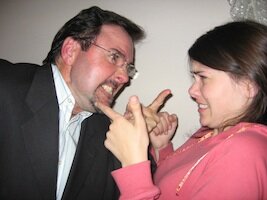DSM-V Criteria for Sexual Identity-based Delusional Disorder (Satire)

Please note: the following is meant as satire only. Trigger warnings for references to homophobic and transphobic violence and bullying.
Remember when homosexuality was in the DSM, listed as a mental disorder? Remember when being trans was in there, too, listed as Gender Identity Disorder? (Oh yeah, that last one is still in there!)
Wouldn’t it be great if we could pathologize homophobia and transphobia the way homosexuality and gender identity have been? Let’s turn the tables on all those who would commit us for being who we are!
I present to you now, my proposal to add the following disorder to the upcoming DSM-V, and the criteria for diagnosis listed below:
Sexual Identity-based Delusional Disorder
A. Persistent belief(s)s about a sexual orientation or gender identity other than one’s expressed sexual orientation or gender identity, as manifested by 1* or more of the following indicators.
1. A persistent belief that the sexual orientation or gender identity in question is unnatural and/or immoral.
2. A persistent belief that people of the sexual orientation or gender identity in question are perverted or disgusting.
3. A persistent belief that people of the sexual orientation or gender identity in question have no place in society and/or do not deserve the same rights as others, up to and including marriage rights that are appropriate to the sexual orientation or gender identity in question.
4. A persistent belief that all people of the sexual orientation or gender identity in question engage in paraphilias generally held unacceptable by society, such as pedophilia, bestiality, and necrophilia.
5. A persistent belief that people of the sexual orientation or gender identity in question are incapable of raising children without harming them.
6. A persistent belief that one’s own sexual orientation or gender identity is superior to the sexual orientation or gender identity in question.
7. A persistent belief that the sexual orientation or gender identity in question should be pathologized in the DSM-V or prohibited by law.
8. A persistent belief that people of the sexual orientation or gender identity in question should be prohibited by law to take part in specific areas of society, such as military or education.
9. A persistent belief that people of the sexual orientation or gender identity in question should be required by societal customs to limit their expression of their sexual orientation or gender identity to in private.
B. Spends energy and/or resources on efforts to disenfranchise people of the sexual orientation or gender identity in question, as manifested by 1* or more of the following indicators.
1. Engagement in efforts or desire to enact laws that prohibit the rights of people of the sexual orientation or gender identity in question, or a sincerely-held desire to do so.
2. Engagement in the discrimination against a person or people perceived to be of the sexual orientation or gender identity in question, or a sincerely-held desire to do so.
3. Engagement in verbally, physically and/or emotionally abusive behaviour toward a person or people of the sexual orientation or gender identity in question, or a sincerely-held desire to do so.
4. Engagement in violent behaviour where the intent is to harm a person or people of the sexual orientation or gender identity in question up to and including lethally, or a sincerely-held desire to do so.
5. Engagement in the sexual assault of a person or people of the sexual orientation or gender identity in question, or a sincerely-held desire to do so.
C. An inability to question belief(s), even when confronted with strong evidence to the contrary.
D. A strong compulsion to compel others to agree with the belief(s) when discussing the belief(s), as manifested by 1* or more of the following indicators:
1. Engaging in circular conversations with people who disagree with the belief(s).
2. Loses temper or becomes easily frustrated with people who disagree with the belief(s).
3. Becomes angry and resentful of people who disagree with the belief(s).
4. Engages in name-calling behaviour with people of the sexual orientation or gender identity in question.
5. Engages in violent behaviour with people of the sexual orientation or gender identity in question.
E. A characteristic lack of remorse, shame, empathy or acknowledgement when confronted with the knowledge that by acting on their delusional belief(s) (verbally or otherwise), they have harmed others psychologically or physically
F. The disturbance is not better accounted for by another mental disorder such as a personality disorder.
G. The disturbance is not due to the direct physiological effects of a substance (e.g., a drug of abuse, a medication) or a general medical condition.
H. The condition is associated with clinically significant distress or impairment in social, occupational, or other important areas of functioning, or with a significantly increased risk of suffering, such as distress or disability**
Specifiers**
Closeted, i.e, the individual expresses his or her sexual orientation or gender identity as different than his or her own to friends, family, colleagues when his or her true sexual orientation or gender identity matches the sexual orientation or gender identity in question.
Religious-based, i.e. the individual expresses that his belief(s) are supported and/or demanded of by his religion or spiritual belief system.
Ouch! Now that’s a label I would never want to have slapped on me by a doctor!

This is awesome. You should suggest it to the writers of the DSM-V. I hear there is a “suggest a disorder” box. How great would it be if a bunch of people suggested this? I have some credentials. We should get everyone with psych degrees or neuro degrees to suggest it.